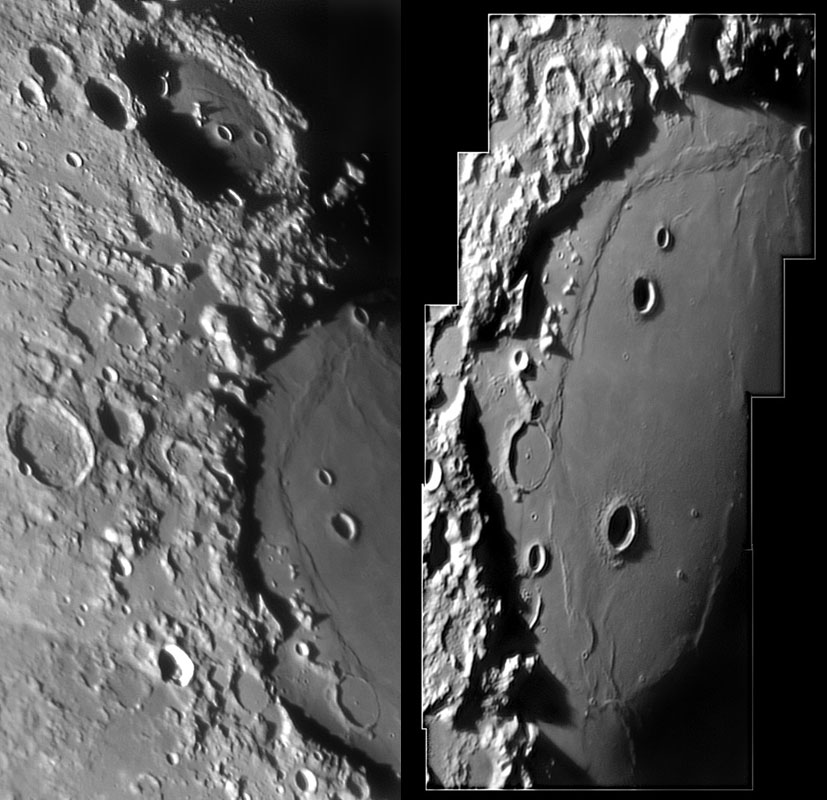|
|
| (8 intermediate revisions by the same user not shown) |
| Line 1: |
Line 1: |
| | __NOTOC__ | | __NOTOC__ |
| − | =Sunset On the Wasatch Mountains= | + | =Sunset on the Wasatch Mountains= |
| | + | <!-- Start of content --> |
| | + | <div class="post" id="post-551"> |
| | | | |
| − |
| + | <div class="storycontent"> |
| − | <div class="post" id="post-551">
| + | <p>[[File:Marecrisium.jpg|Crisium-Grenier]]<br /> |
| − |
| |
| − | <div class="storycontent">
| |
| − | <p>[[File:Marecrisium.jpg|Crisium-Grenier]]<br />
| |
| | <em>images by [mailto:jeromegrenier@free.fr Jérôme Grenier]</em></p> | | <em>images by [mailto:jeromegrenier@free.fr Jérôme Grenier]</em></p> |
| − | <p><em>This is a replay of a great pair of images originally featured on the Feb 3, 2006 LPOD. No body seemed to notice that I gave a name to the Crisium Basin rim mountains! Re-enjoy!</em></p> | + | <p><em>This is a replay of a great pair of images originally featured on the Feb 3, 2006 LPOD. Nobody seemed to notice that I gave a name to the Crisium Basin rim mountains! Re-enjoy!</em></p> |
| | <p>Although basins are the biggest impact features on the Moon, on the nearside we get to see relatively fresh rim segments only at the Altai and Apennine mountains. At other basins the rims are much reduced in height or virtually gone altogether. Crisium is an intermediate to young basin that still preserves a massive rim nearly all around the mare. Using the Lunar Topographic Orthophotomaps (LTO) at the [http://www.lpi.usra.edu/resources/ Lunar & Planetary Institute] it is possible to get a firm understanding of the dimensions of part of the Crisium basin rims. The main rim – which lacks a name so I henceforth call them the Wasatch Mts – rises 5.4 km above the nearby Mare Crisium west of Yerkes and 5.0 km above the mare west of Swift (Peirce B). Interestingly, the Oppel mare ridge - the wrinkle ridge between Swift and the basin rim and continuing on down between Picard and the rim – marks a 350 m step down to the central part of the mare. The mare surface to the west of the ridge is 4100 m high, the ridge crest is 3960 m, and the mare to the east is at 3750 m. We lack such excellent topo maps for most of the Moon so we can’t confirm that all other mare ridge basin rings are also faults – but it is a good guess!</p> | | <p>Although basins are the biggest impact features on the Moon, on the nearside we get to see relatively fresh rim segments only at the Altai and Apennine mountains. At other basins the rims are much reduced in height or virtually gone altogether. Crisium is an intermediate to young basin that still preserves a massive rim nearly all around the mare. Using the Lunar Topographic Orthophotomaps (LTO) at the [http://www.lpi.usra.edu/resources/ Lunar & Planetary Institute] it is possible to get a firm understanding of the dimensions of part of the Crisium basin rims. The main rim – which lacks a name so I henceforth call them the Wasatch Mts – rises 5.4 km above the nearby Mare Crisium west of Yerkes and 5.0 km above the mare west of Swift (Peirce B). Interestingly, the Oppel mare ridge - the wrinkle ridge between Swift and the basin rim and continuing on down between Picard and the rim – marks a 350 m step down to the central part of the mare. The mare surface to the west of the ridge is 4100 m high, the ridge crest is 3960 m, and the mare to the east is at 3750 m. We lack such excellent topo maps for most of the Moon so we can’t confirm that all other mare ridge basin rings are also faults – but it is a good guess!</p> |
| | <p>[mailto:tychocrater@yahoo.com Chuck Wood]</p> | | <p>[mailto:tychocrater@yahoo.com Chuck Wood]</p> |
| Line 18: |
Line 17: |
| | [http://www.lpi.usra.edu/resources/mapcatalog/LTO/lto62a1_1/ Yerkes LTO]<br /> | | [http://www.lpi.usra.edu/resources/mapcatalog/LTO/lto62a1_1/ Yerkes LTO]<br /> |
| | [http://www.lpi.usra.edu/resources/mapcatalog/LTO/lto44d4_2/ Pierce LTO]</p> | | [http://www.lpi.usra.edu/resources/mapcatalog/LTO/lto44d4_2/ Pierce LTO]</p> |
| | + | <p><b>Yesterday's LPOD:</b> [[September 12, 2006|A Handy Guide to Gassendi]] </p> |
| | + | <p><b>Tomorrow's LPOD:</b> [[September 14, 2006|Unbelievable Image]] </p> |
| | <p>Comment:<br /> | | <p>Comment:<br /> |
| | Superb images with an 8″ scope. Left hand image shows a great view of the point where Prom Lavinium and Prom Olivium almost touch (see bottom right of LEFT image). This was where Wilkins confirmed his 2km wide arch "bridge", using the 60″ (?)Mt Wilson reflr. I’ve made one drawing of the site that I’ll submit, also using an 8″. No "bridge" tho.<br /> | | Superb images with an 8″ scope. Left hand image shows a great view of the point where Prom Lavinium and Prom Olivium almost touch (see bottom right of LEFT image). This was where Wilkins confirmed his 2km wide arch "bridge", using the 60″ (?)Mt Wilson reflr. I’ve made one drawing of the site that I’ll submit, also using an 8″. No "bridge" tho.<br /> |
| | Regards. Harry</p> | | Regards. Harry</p> |
| | <p>Comment by harry roberts — February 10, 2006 @ 5:17 pm</p> | | <p>Comment by harry roberts — February 10, 2006 @ 5:17 pm</p> |
| − | </div>
| + | </div> |
| − |
| + | <!-- End of content --> |
| − | | + | {{wiki/ArticleFooter}} |
| − | ---- | |
| − | ===COMMENTS?===
| |
| − | Click on this icon [[image:PostIcon.jpg]] at the upper right to post a comment.
| |




